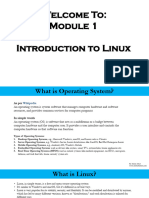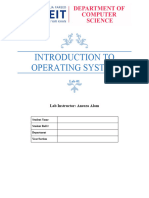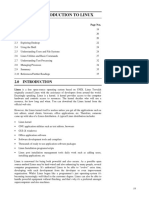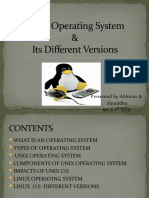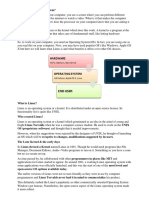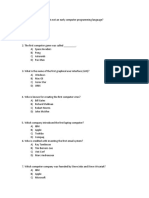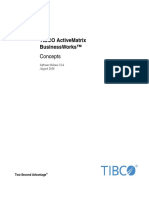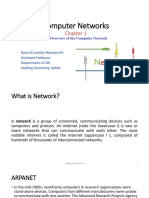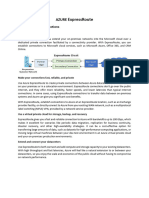Module 1
Operating System
• An operating system (OS) is system software that manages computer hardware and software
resources and provides common services for computer programs.
• OS as a Middle Layer / Bridge
• The OS acts as a bridge between the computer and the user.
• It provides a user interface and controls the computer hardware so that software can function
effectively.
Types of Operating Systems
1. Desktop Operating Systems – Windows, macOS, and Linux (e.g., Ubuntu).
2. Server Operating Systems – Windows Server, CentOS, Red Hat Enterprise Linux.
3. Mobile Operating Systems – Android, iOS.
4. Embedded Operating Systems – Used in routers, smart TVs, and automobiles.
5. Real-Time Operating Systems – Used in medical equipment, aerospace, defense, network firewalls,
and home security systems.
What is Linux?
• Linux is a free and open-source operating system.
• It is popular for its stability, security, and flexibility.
• It can be modified and distributed by anyone.
• Its open-source nature means that a community of developers continues to contribute to its
development.
Importance of Linux
• Widely used in servers and cloud computing.
• Supports the free software philosophy.
• Has a strong command-line interface.
• Faster processing compared to some other OS.
• Enhanced security due to fewer vulnerabilities.
• Highly customizable because of its open nature.
History of Linux
Before Linux
UNIX was developed in the 1970s at AT&T Bell Labs by Ken Thompson and Dennis Ritchie.
In 1983, Richard Stallman launched the GNU Project to create a free UNIX-like OS.
Birth of Linux
In 1991, a 21-year-old Finnish student, Linus Torvalds, created Linux.
August 25, 1991 – Linus announced the project on the Minix newsgroup.
September 1991 – Version 0.01 was released.
Later in 1991 – Version 0.02 was released.
1994 – Linux 1.0 was launched.
2000s – Linux saw significant adoption in the server market.
2007 – Google introduced Android OS, which is based on Linux.
UNIX vs Linux
Feature Feature Linux
Developer Developed by AT&T, GE, and Developed by Linus
MIT in 1970 at Bell Labs Torvalds in 1991
File System Support Supports fewer file systems Supports a wide range of
file systems
Hardware Compatibility Can be installed on specific Can be installed on a wide
hardware range of devices
Linux Distributions (Flavors)
A Linux distribution is a version of Linux bundled with various software and package
managers.
Popular Linux Distributions:
• Ubuntu (by Canonical Ltd.)
• Fedora (by Red Hat)
• Debian
• Red Hat Enterprise Linux (by Red Hat)
• CentOS
• Arch Linux
• OpenSUSE
• Linux Mint
• Gentoo Linux
• Slackware Linux
• Alpine Linux
• Kali Linux
Linux vs Windows
Feature Linux Windows
Source Type Open-source Proprietary software
Cost Free Paid
User Interface Multiple desktop Standard UI across
environments (GNOME, versions
KDE, XFCE)
Command Line Core feature (Bash, Uses Command Prompt
Terminal) and PowerShell
Software Installation Uses package managers Uses .exe installers
like APT, YUM, Pacman
Security More secure with fewer More vulnerable to
malware threats malware
Performance Known for stability and Can slow down over time
performance
File Systems Supports ext4, XFS, Btrfs Uses NTFS, FAT32






